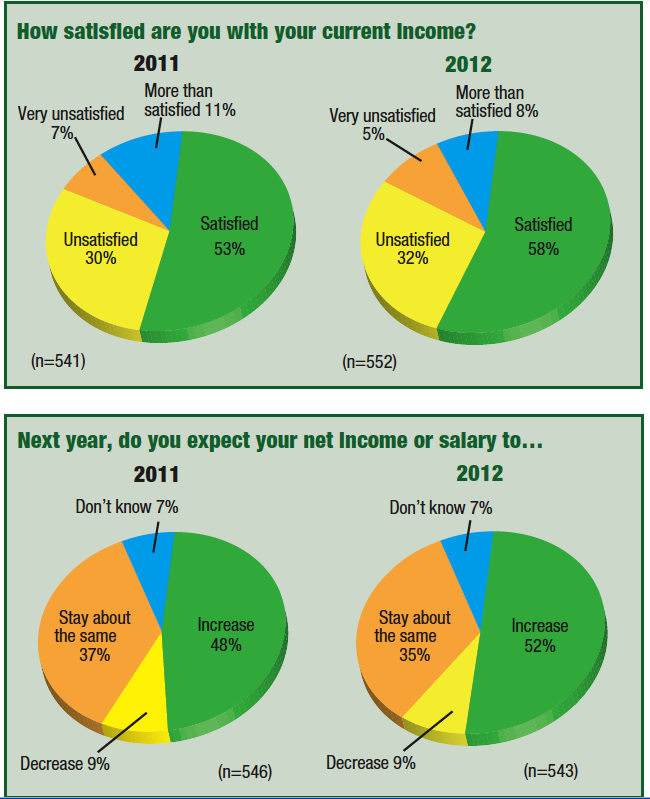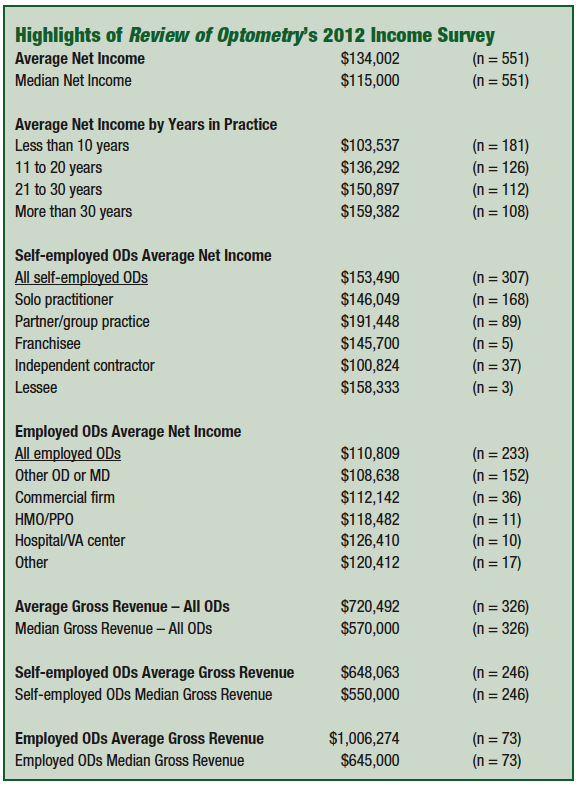 |
“It’s enough, but we’re having to work harder and smarter to keep up,” says solo practice optometrist Frank Houser, of Jacksonville, Fla. ODs are keeping up—barely.
Annual net income for all optometrists (including both employed and self-employed ODs) averaged $134,002 in 2012, according to our latest income survey. That number is actually down from last year’s survey—the average OD’s net income was $137,806 in 2011, which equals a decrease of 2.8%.
“I work a whole lot harder to make the same amount of net,” says Clark Weeks, OD, of Winfield, Ala. Bear in mind that very high or very low individual salaries may skew the results. Median income—the midpoint of all responses—may provide a better snapshot of the typical OD’s income. In 2012, median income for all optometrists was $115,000—which was the exact same number in our 2011 survey. So, that’s good news.
“Considering that I opened cold just three years ago, I am pleased that I am able to pay myself that [level of] salary for having a brand new practice,” says Tina R. Thomas, OD, of Washington, Ill.
For self-employed ODs, annual net income (i.e., income minus taxes) averaged $153,490 in 2012, and median income was $130,000. For employed ODs, annual net income averaged $110,809 and median income was $105,000. Those are almost the exact same numbers as in last year’s survey.
These are some highlights of Review of Optometry’s annual Income Survey. The survey was emailed to more than 30,000 of our readers; about 14,000 opened the email and more than 700 optometrists responded. We received many insightful answers to one key question—What one thing do you plan to do to increase your income in the coming year? The answers we received can be categorized into eight great ideas.
 1. Try Something New
1. Try Something New
If the same old streams of income are not flowing well or are simply drying up, try tapping a new revenue stream. “We decreased occupancy costs by bringing in audiology,” says LeRoy Popowski, OD, of Colorado Springs, Colo. “I paid off my practice loan.”
“We’re offering more small side items to help patients and revenue, like Bruder moist heat eye pads, nutrients like omega-3s and macular vitamins, OCT wellness exams and TearLab osmolarity testing,” says Jeanette Jezick, OD, of Gales Ferry, Conn.
2. See More Patients
ODs are taking different approaches to increasing productivity. “I may work more hours,” says Tammy Warmouth, OD, of Luzerne, Pa.“I’m bringing in an associate,” says Eric White, OD, of San Diego. Similarly, “I’ll hire a new, young doctor to help increase production,” says Thomas Tucker, OD, of Greenville, SC.
“We’re increasing patient load from the Affordable Care Act,” says Curt Gottlieb, OD, of Doylestown, Pa.
3. Expand Your Services
In addition to mining existing routes for more patients, ODs are broadening their assortment of services. “We’re adding ortho-K and scleral lenses,” says Keith Kajioka, OD, of Modesto, Calif. Likewise, Sophia Asaria, OD, of Houston, plans to “have more specialty contact lens fittings.”“I am opening a VT practice,” says Angela Howell, OD, PA, of Paragould, Ark. Jonathan Shaver, OD, of Fayetteville, Ark., identified two new ventures for his practice: “We began a dry eye clinic, and we’re beginning to work at a school-based clinic.”
4. Increase Medical Eye Care
Optometrists’ latest “goose that lays golden eggs” is medical eye care. This notion is apparently not an elusive fairy tale, but a reality for many ODs. “We’re doing more medical eye care,” says David Zehnder, OD, of Delaware, Ohio. “We started an AMD center and a dry eye center.”Other ODs are taking a similar approach:
• “I’m doing more medical testing, such as for glaucoma visits,” says Jean S. Heisman, OD, of Mullica Hill, NJ.
• “I’m adding retinal imaging to my practice,” reports Krystal Long, OD, of Minneapolis.
• “I just bought an OCT to increase medical revenue,” says Meyer Izaac, OD, of Encino, Calif.
5. Go High End
“While our competition continues to race to the bottom in buy-one/get-one deals, discounts and sales, we have gone to higher-end and exclusive lines,” says Mario Barrera, OD, of Laredo, Texas. Other ODs also report that high end equals higher revenue. “We are continually trying to set ourselves apart from others by unique things that we do in our office,” says Dr. Thomas. “As a result of these things that we’ve been doing, we are continually growing.”Optometrist Barry Basden, of Florence, Ala., added a personal touch. “We’ve recently implemented a technician/scribe/optician program that dramatically improves rapport with our patients. Our techs function as the patient's advocate through the entire examination process as well as the selection of eyewear. We’re seeing significant improvement in throughput and optical sales.”
Steven N. Sugar, OD, of Sugar Land, Texas, takes an assertive approach to sales. “We train our staff to sell, sell, sell—to upgrade lenses and offer add-ons,” he says. “We keep our schedules full all the time. We are very selective in the vision plans that we accept, because they are all changing and not in our (the doctors’) best interest.”
 6. Raise Prices
6. Raise Prices
Increasing fees and raising prices can be a tricky endeavor, but it’s one that every practice owner has to address from time to time. “We may increase the price of retail products and professional fees by five percent,” says Husam Tarrabain, OD, of Edmonton, Alberta, Canada.
7. Keep an Eye on Costs
One problem practice owners continually face is the ever-increasing cost of retail goods. So, it’s important for all business owners to keep a lid on those expenses. Here are some specifics: Brian Beattie, OD, of Bismarck, ND, plans on “better collection practices and using a buying group to control costs.”Matt Stanley, OD, of Manhattan, Kansas, hopes to “decrease the cost I spend on maintaining my hardware/network/computers by possibly switching to a new cloud-based EHR.”“We restructured our insurance billing and accounts receivable departments to improve our cash flow,” says Dr. Basden. “We also made changes in the processes we use to purchase products.”
Several respondents say that they aim to raise revenue by combining cost-cutting measures with ones to increase income. For instance, Evelyn Segovia, OD, of Humble, Texas, says that she’s “ensuring that all insurance is filed, and that I made an attempt to upgrade or get additional pairs of glasses sold.”
Likewise, “we’re collecting co-pays consistently while achieving a higher percentage of lens treatments, such as AR and photochromatic coatings,” says Linda Nguyen, OD, of Kahului, Hawaii.
8. Improve Marketing
The old advertising advice still holds true: If you don’t tell, you won’t sell. That’s why it’s important for many practices to make sure the people in their community know they’re there. But you need a plan. “We are going to create a detailed marketing calendar for next year,” says Alexander Jennings, OD, of Cudahy, Wisc.Besides a solid plan, you need good ad placement—the old phone book ad doesn’t work so well any more. You need new ideas that show that you’re a part of your community. Jon Montoya, OD, of Albuquerque, NM, says, “More people will know about us through self-advertising, flyers, charity works and sponsorships we are doing this year.”
More Info from Our Income Survey
In addition to these ideas, our latest income survey yielded some other interesting information.• Fewer hours. Over the past several years of this survey, we’ve seen a very gradual decrease in hours worked per week. However, 2011 was an exception to that trend; the average OD put in 39.4 hours per week. (These numbers reflect a total of patient hours plus administrative time.) But 2012 resumed that downward trend, with an average work-week of 38.2 hours. Perhaps this exemplifies optometrists’ new outlook of working smarter, not harder. Self-employed optometrists put in more hours than employed ODs—38.7 hours vs. 37.4 hours.
• Projected future earnings. Optometrists are optimistic about a profitable 2013. More than half (52%) expect their income to increase in 2013, which is higher than what we’ve seen since the beginning of the economic downturn. Meanwhile, 35% hope their income will at least remain the same. Only 9% foresee a decrease in their income in 2013.
• Job satisfaction is up. Unfortunately, money can’t buy you happiness. But, on a brighter note, optometrists report that they’re a bit more satisfied—and not as unsatisfied—with their current income. Specifically, 66% of respondents reported satisfaction with their 2012 income compared to 64% in 2011. At the same time, only 5% of ODs reported they were “very unsatisfied” in 2012, compared to 7% who were “very unsatisfied” in 2011. Summing it up, Dr. Heisman says, “I feel that I am making a very good income; but more importantly, I enjoy what I do.”

